CG Animator Naoki Yoshibe on Effects Animation and JoJo’s Openings
The animator and director explains his process, influences, and approach to balancing 2-D and 3-D animation.
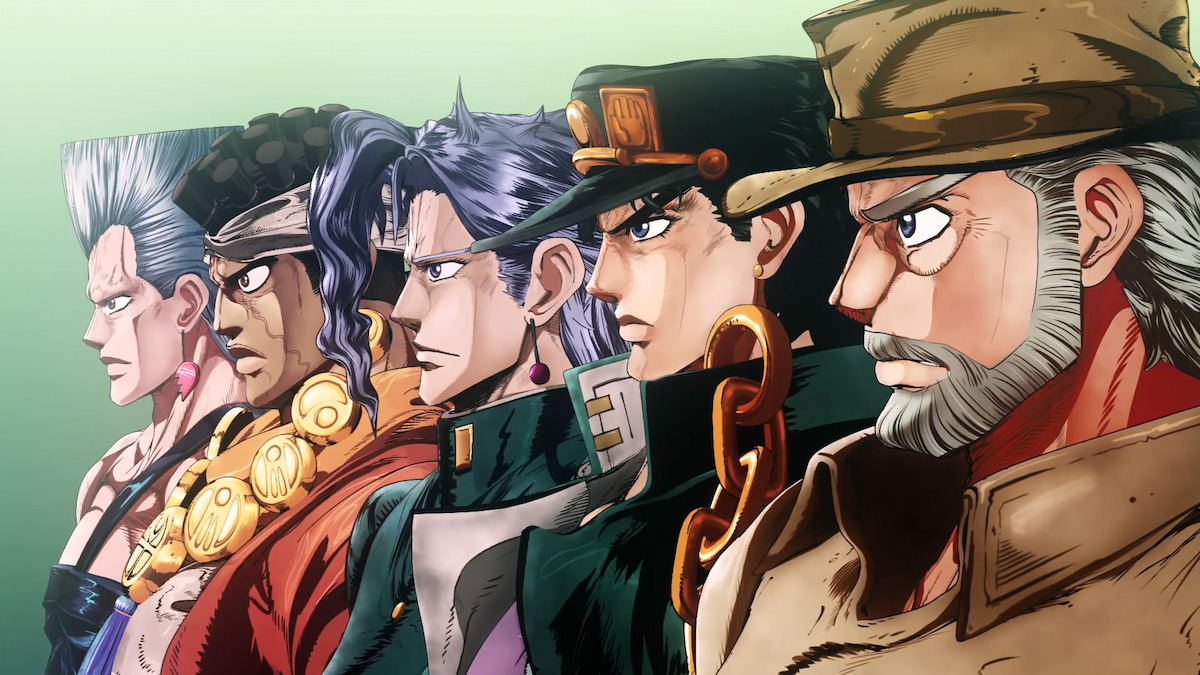
The David Production JoJo’s Bizarre Adventure series have always had a striking visual style, but the sequences that stood out most to fans in the early seasons were the opening animations (OPs). Featuring a mix of 3-D models, 2-D effects, and striking motion graphics work, the openings look completely different from the rest of the show and, frankly, most other anime. At Otakon 2019, I sat down for a chat with Naoki Yoshibe, the director of those OPs. He specializes in dynamic digital animation that combines the best of 2-D and 3-D — a style he has used to great effect in the openings to JoJo’s, Gatchaman Crowds, and Hanebado as well as the Animator Expo short “Tokio of the Moon’s Shadow.” His JoJo’s OPs were created during his time at studio Kamikaze Douga (Pop Team Epic), but at the time of this interview he was working at Studio Orange (Beastars, Land of the Lustrous). Among his directorial work at Orange is a rollicking IDOLM@STER: Cinderella Girls short film, “Spin-Off!” In the interview, we cover his influences and digital workflow and delve into the details on some of his key projects.
Thank you to Otakon’s guest and press staff, Studio Orange, and Mr. Yoshibe, for the opportunity.
Ani-Gamers: Let’s start by talking about effects animation. How did you end up working in that niche?
Naoki Yoshibe: I originally really liked anime, and in the action scenes and every scene that I made, I felt the urge to keep making more, because it’s exciting. I feel that excitement.
Ani-Gamers: Did you do any specific training in effects animation?
Yoshibe: Originally I tried to remake the motions and movements I liked from different scenes, such as the “Itano Circus” (EDITOR’S NOTE: Ichiro Itano’s famous vapor trails effect), and that’s where I got my start from.

Ani-Gamers: Are there any other examples of particular effects that really stood out to you in anime, film, video games, or anything else?
Yoshibe: In episode 133 of Naruto, the fight scene above water that Norio Matsumoto created. The action scene is exciting, but since they’re fighting over water, there’s also that water effect continuously going on.
Ani-Gamers: One of the things that’s really interesting about your work, especially the JoJo’s openings, is that it combines 3-D animation with 2-D effects. And in the Studio Orange panel you said that certain effects — like water effects, fire, and explosions — are harder to do in 3-D than 2-D. How do you make the decision about when to use 2-D vs. 3-D?
Yoshibe: I like to get the shape and the effect of the motion. The water effects that look liquidy but also look like flame. That kind of goes back with what I said in my previous answer.
For the third part of JoJo’s, I created the broken glass effect. I wanted to show the reflections of each broken part of glass.
Ani-Gamers: In the end, the “ora ora ora” scene?
Yoshibe: Yeah.
Ani-Gamers: So that was a point where 3-D was better suited?
Yoshibe: Right.
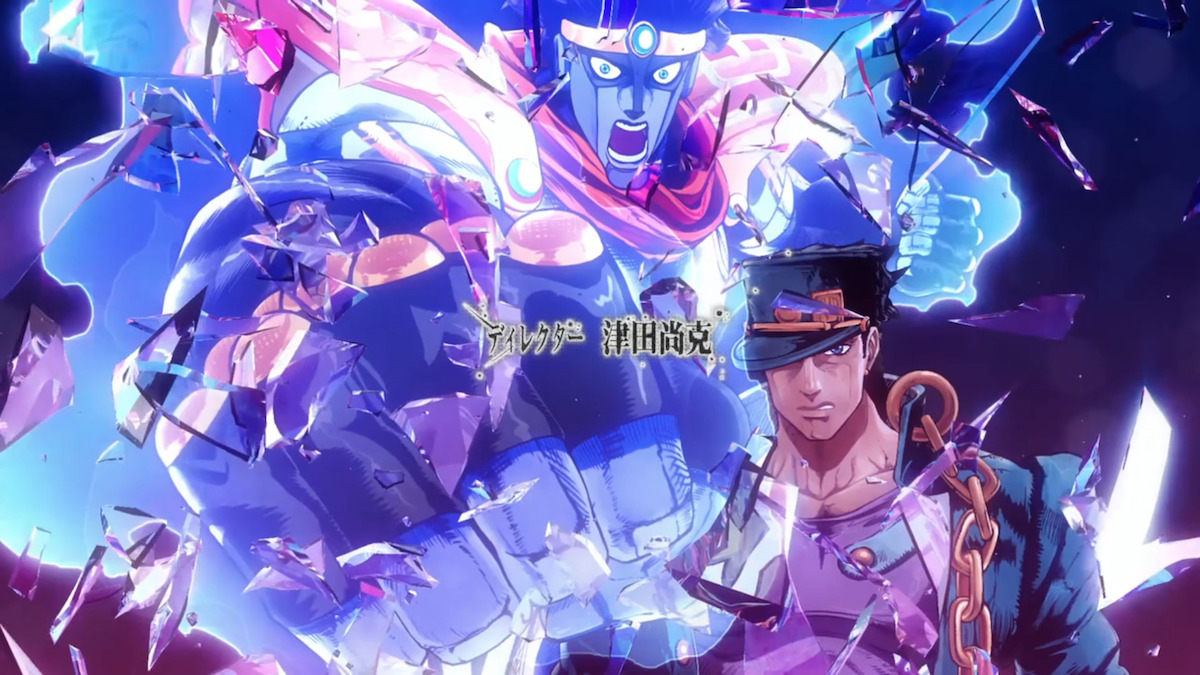
Ani-Gamers: There’s this effect you’ve done in a lot of your JoJo’s openings. It’s this really sketchy effect that one of the Pillar Men does. I don’t see as much of it in your other work. You tend to use more clean effect lines and things. How did you decide to go in that direction and develop that effect?
Yoshibe: The main character is obviously CG, but for the villains, like the Pillar Men, I worked to show the [difference between] good and evil — to show the evil aura of the Pillar Men.
Ani-Gamers: Did you draw that yourself or was that a different animator?
Yoshibe: That was me. Sometimes in anime, there are some scenes where there’s only pencil drawings and illustrations. I liked those kinds of effects.
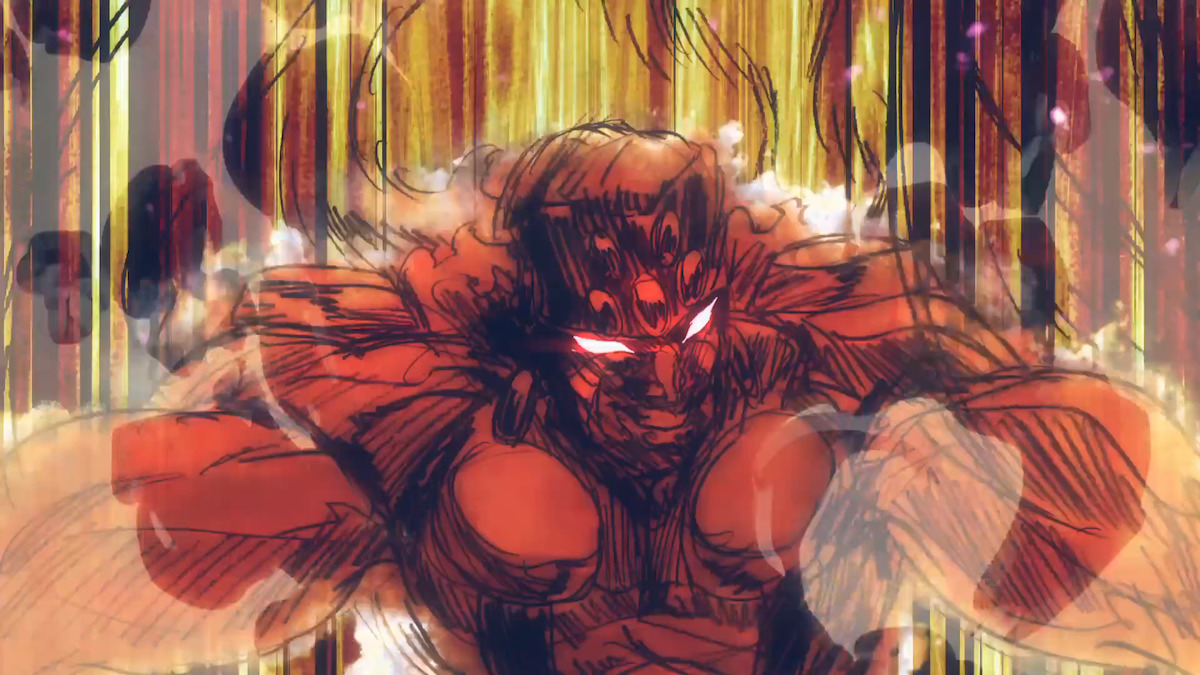
Ani-Gamers: Speaking of the JoJo’s openings, how did you end up working on them? How was their style decided?
Yoshibe: For the visuals, since there we already had Araki’s colored illustrations, I wanted to get close to that and achieve the same feeling as that.
Ani-Gamers: Typically an anime opening sequence will look a lot like the show itself, but those OPs look different from the rest of the show. Was that something the director was specifically looking for?
Yoshibe: The director acknowledged me doing so, but said I could produce basically whatever I wanted to.
Ani-Gamers: I have some questions about OPs because a lot of your directing experience is in that medium. How did you end up with that as your specialty? Do you really like OPs in particular?
Yoshibe: I wanted to do them. When I watch anime, I also like to watch the openings as well. It’s also my hobby.
Ani-Gamers: Do you have any favorite anime openings?
Yoshibe: Evangelion, the Generator Gawl opening from Kazuto Nakazawa, Mospaeda. Also mostly all the Naruto openings.
Ani-Gamers: You’ve also directed some non-opening sequences. What are some special considerations you have to make when directing an opening vs. a more traditional scene?
Yoshibe: So I’ll have the music, and then I’ll have to [find and] create something that goes [well] with the music. And since it’s only about a minute and 30 seconds, it’s really short. So I can put in as many things as I like in that short span of time. That’s another reason why I like creating openings.
Ani-Gamers: Anime openings have a lot of conventions to them: characters running, things like that. In some ways I think your OPs break from those conventions. How do you decide when to put in one of those standard elements versus playing around with something else? For example, things like motion graphics that you use in your openings.
Yoshibe: There’s the format that you were talking about. And sometimes I like to follow that format, so it’ll give a touch [of the standard format]. But I don’t only like Japanese anime openings. I also like Hollywood title sequences. Saul Bass, Hitchcock movies, things like that. The graphical mix and also having the theme of the movie inside of that short segment is really cool and I like watching them. I want to make animation that’s not just showing characters.
Ani-Gamers: Where the animation itself is expressing the tone of the series?
Yoshibe: Yes.

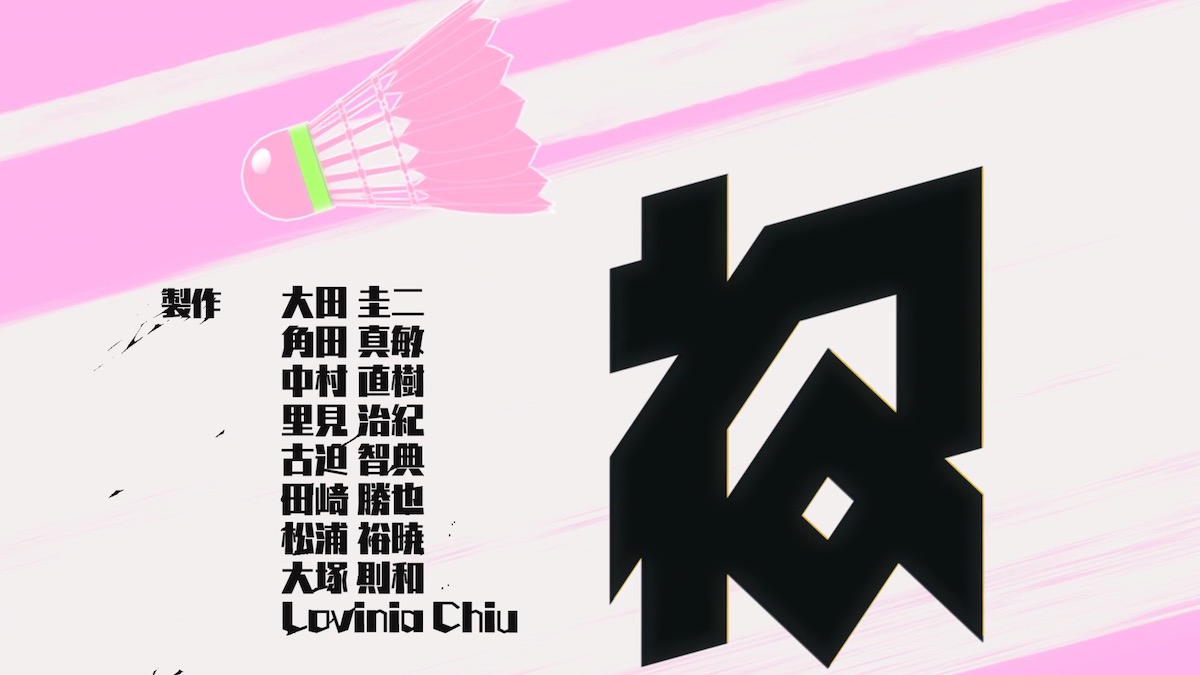
Ani-Gamers: Regarding Hollywood movies, sometimes when I watch your animation, especially some of your personal work on YouTube and elsewhere, I was wondering if you have any big influences in non-Japanese animation, because it feels like that.
Yoshibe: One of my favorite title sequences is actually 007: Skyfall. That title sequence is really cool. I also like this British group called Golden Wolf Productions. I like their movies and sequences.
Ani-Gamers: I assume this wouldn’t be on your list, but one of your effects demo reels made me think of Norman McLaren, the Canadian animator.
Yoshibe: Yeah. In college, I actually studied animation, and in those times, you get into learning the history of animation. Like Norman McLaren and Saul Bass. That’s how I got to know them.
Ani-Gamers: I want to talk a little bit about your digital animation process. What software do you tend to use?
Yoshibe: Photoshop, After Effects, and other Adobe software … and Clip Studio Paint, made by a Japanese company called Celsys. Those are the main tools that I use.
Ani-Gamers: Do you do much drawing with pencil and paper, or is it entirely digital?
Yoshibe: It’s mostly all digital. When I want to feel the texture on paper, I sometimes use a pencil or a brush or something.

Ani-Gamers: There’s an effect that you do on the two Gatchaman Crowds OPs, where you composite animation and cutouts on top of live footage. What was the process for shooting and compositing all that?
Yoshibe: For the first one, I actually went to a place called Tachikawa in Tokyo and I took pictures so I could use them to create it. The setting is very in-real-life, so you’ll use similar structures, and the era is very modern, so that’s why I went out to see by myself and took pictures to create it.
Ani-Gamers: I think in the second one it’s supposed to look like there are actual paper cutouts in the city. Did you shoot real ones or did you composite them on top?
Yoshibe: When I first made the animation, I just used the regular pictures and composited the animation. But when I thought of making the second one, I wanted to update the concept from the first one, so I brought in the actual height panels on location to shoot pictures.
Ani-Gamers: So it was true stop-motion?
Yoshibe: Actually, two slides are composited, but basically the whole thing is taken in real life in person.
Ani-Gamers: Who has those standees now? Where are they?
Yoshibe: Oh, yeah. I think they’re at Tatsunoko Productions.
There are actually a bunch of different panels so I couldn’t take them home.
For the second opening, there’s an assistant director named Erusa Nakamichi who shot the actual pictures.
Ani-Gamers: You worked at Kamikaze Douga, and now you’re at Orange (EDITOR’S NOTE — Yoshibe is no longer at Orange). How is the working environment different between them and Orange?
Yoshibe: Kamikaze Douga actually started with independent work. So when they first started, there were only three people and when I joined, there were roughly 10 people. So good or bad, it’s mostly independent work. Orange is basically people who were working on CG inside anime. So it’s sometimes systematic, but some producers are also experimental. There’s that balance of experimenting and doing systematic animation.
Ani-Gamers: What do you mean by “systematic?” Are you talking about using the pipeline as it already is vs. experimenting and coming up with a new one?
Yoshibe: There’s the pipeline for making the CG in anime, so it’s more constructed. It’s the balance between doing new things, experimenting, and using the existing pipelines to make things.
Ani-Gamers: What was it like doing directing work on “Tokio” for Animator Expo?
Yoshibe: I was actually the assistant because the main director was Mizuno from Kamikaze Douga. Now that I think about it, in terms of the effects that show the story, I should have thought more about it when I was making it.
Ani-Gamers: For example?
Yoshibe: It’s not really specifically something that I thought was wrong, but I just overall think some places I could have done better. And actually at Orange right now, I’m trying to make something with more story. Right now I really think about both the main story and the characters. How they think and what they’re thinking upon action. So maybe that’s what I should have thought more at the time.
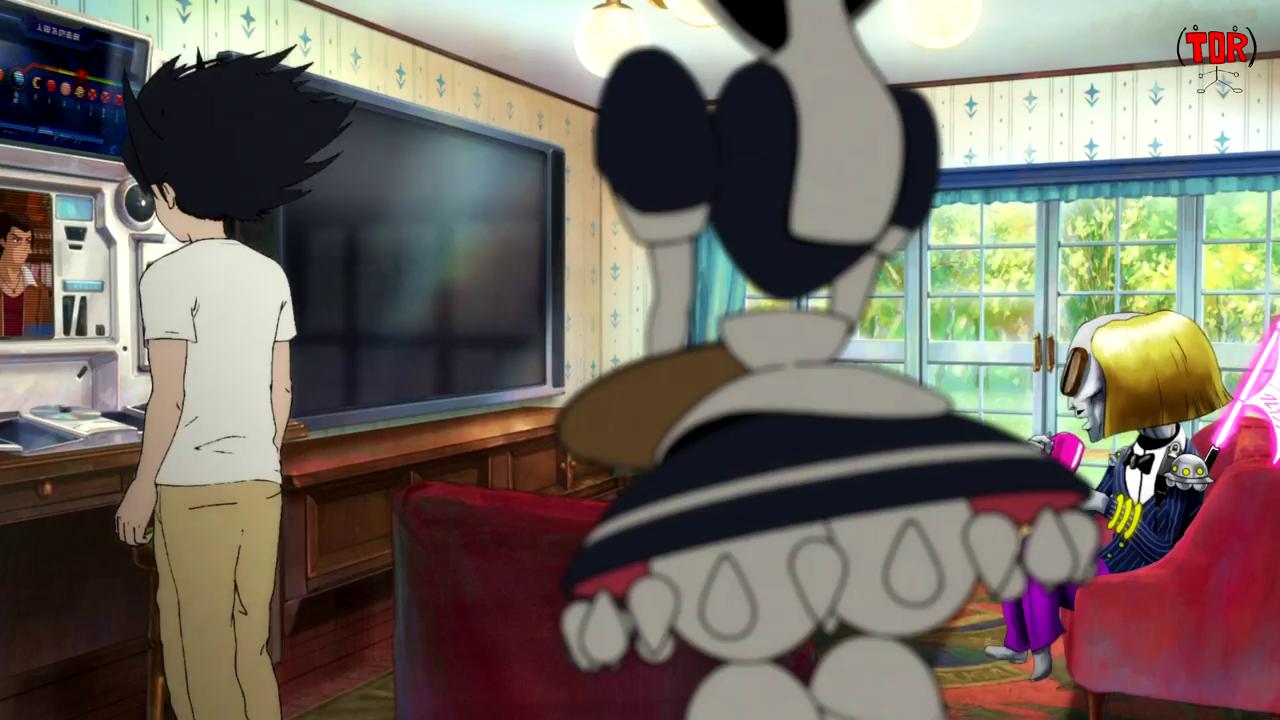
Ani-Gamers: The animation is really eccentric in that short. How much were you part of coming up with and how much was the director? Like there’s a character who’s a weird composited-in 2-D character, and there’s a sequence where you see things through a robot’s eyes and everything’s wobbly.
Yoshibe: It was the producer‘s call that it would be left to Mizuno from Kamikaze Douga and the people from AC-bu that they’d been working with in the past. So it was the producer’s call to select them to work on that.
Ani-Gamers: Oh, AC-bu from Pop Team Epic’s “Bob Epic Team” segments!
Yoshibe: Yeah, Kamikaze Douga and AC-bu have been together for a long time.
Ani-Gamers: You spend a lot of time on Twitter explaining your process and talking your audience through that, and you released a book about animating in Clip Studio Paint. What draws you to that process about educating other artists about digital animation?
Yoshibe: There are actually a lot of young creators on Twitter, and I myself get feedback from them. Maybe if I project that information to as many creators as I can, maybe there are a handful of creators who will actually get better. Maybe what I’m doing is the best for anime creators in general. I also get that feedback as well. And maybe they can work with me one day.
Check out more of our Otakon 2019 coverage.
